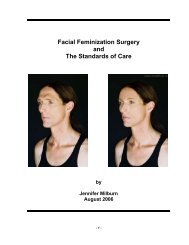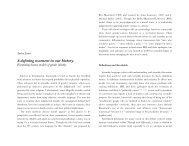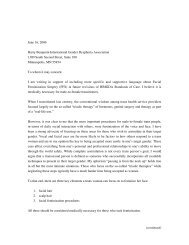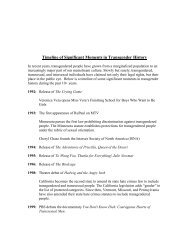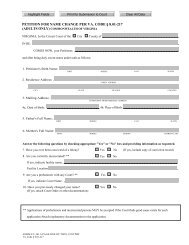Psychophysiological and subjective sexual arousal - Transsexual ...
Psychophysiological and subjective sexual arousal - Transsexual ...
Psychophysiological and subjective sexual arousal - Transsexual ...
- No tags were found...
Create successful ePaper yourself
Turn your PDF publications into a flip-book with our unique Google optimized e-Paper software.
240 L. A. Brotto et al.<strong>subjective</strong> reactions to the film given that the sixdomains of this scale might be theoretically related. Ap level of 0.05 / 6 = 0.008 was thus set for thesecomparisons. For analysis of all other variables, a plevel of 0.05 was deemed significant.ResultsDemographic informationAll 15 MTF individuals completed the studyprocedures in their entirety. Participants were anaverage of 43.2 years old (range 33–55) <strong>and</strong> receivedSRS approximately 24 months earlier (range 12–60months). All participants received penile skin inversionsurgery <strong>and</strong> were receiving follow-up care at thesame clinic. At the time of participation in this study,the average vaginal length was 8.9 cm (range 5.5–11.6 cm). Vaginal length was unrelated to time sincesurgery (p 4 0.05). Four participants were involvedin a <strong>sexual</strong> relationship at the time of physiologicaltesting. Eleven women identified as having a largelyor entirely hetero<strong>sexual</strong> orientation (i.e., attracted tomen), one woman as equally homo<strong>sexual</strong> <strong>and</strong>hetero<strong>sexual</strong>, <strong>and</strong> three women as largely or entirelyhomo<strong>sexual</strong> (i.e., attracted to women). Fourteenwomen were Caucasian <strong>and</strong> one was First NationsCanadian. Ten participants were currently employed,four women were either retired orunemployed, <strong>and</strong> one did not provide employmentinformation.Questionnaire dataBISF-W subscale totals (means <strong>and</strong> SEM) are listedin Table I. On all subscales, scores were found to bein the lower half of the normative range for thisquestionnaire despite the finding that scores on theTable I. Responses to items on the Brief Index of SexualFunctioning for Women (BISF-W) in post-surgical MTF women.The number of women the data are based upon are listed. Datarepresent means (+ st<strong>and</strong>ard error of the mean).BISF-WsubscalenMean(+ SEM)Maximumpossible scoreThoughts/15 5.93 (1.34) 12desireArousal 15 3.00 (0.63) 8Frequency of15 2.10 (0.48) 6<strong>sexual</strong> activityReceptivity/6 8.67 (1.02) 15initiationPleasure/orgasm 11 2.66 (0.54) 8Relationship15 5.20 (1.02) 12satisfactionProblemsaffecting <strong>sexual</strong>function15 2.29 (0.44) 16For all scales except the ‘‘Problems affecting <strong>sexual</strong> function’’,higher scores denote better <strong>sexual</strong> function. For the final subscale,higher scores indicate more problems affecting <strong>sexual</strong> function.‘‘Problems affecting <strong>sexual</strong> function’’ subscale werevery low, indicating no <strong>sexual</strong> problems. Responseson the Detailed Assessment of Sexual Arousal with amaximum score of 7, revealed the average level ofmental <strong>sexual</strong> <strong>arousal</strong> to various types of <strong>sexual</strong>stimuli to be 5.00 (SEM = 0.28). Awareness of nongenitalphysical <strong>arousal</strong> was 4.7 (SEM = 0.37),awareness of genital <strong>arousal</strong> was 4.57(SEM = 0.41), <strong>and</strong> self-reported pleasure from directgenital stimulation was 4.67 (SEM = 0.48). Sixwomen (40%) reported an ability to attain orgasmby at least one means (e.g., clitoral stimulation,intercourse, vibrator use, fantasy). Ten women(67%) reported being satisfied with their orgasmicfunction, three women (20%) reported being dissatisfiedor distressed, <strong>and</strong> two women (13%) did notcomplete this item.Effects of erotic stimuli on physiological <strong>sexual</strong> <strong>arousal</strong>As suggested by Table II, the effect of the erotic filmon physiological <strong>sexual</strong> <strong>arousal</strong> was not significant,t (14) = 0.147, p 4 .05 (mean VPA increase duringneutral condition = 4.94 mV <strong>and</strong> mean VPA increaseduring erotic condition = 4.83 mV). Closer examinationof individual VPA profiles indicates that therewere numerous movement artefacts throughout theVPA signals, which rendered data reduction <strong>and</strong>analysis difficult, even with software artefact removal<strong>and</strong> smoothing. We chose a r<strong>and</strong>om sample of fourVPA outputs to illustrate the magnitude of movementartefacts (see Figure 1).Effects of erotic stimuli on self-report measures of <strong>arousal</strong><strong>and</strong> affectAs shown in Table II, the erotic film significantlyincreased self-reported autonomic <strong>arousal</strong>, t(14) =75.00, p 5 0.001; perceptions of genital <strong>arousal</strong>,t(14) = 74.84, p 5 0.001; <strong>subjective</strong> <strong>sexual</strong> <strong>arousal</strong>,t(14) = 74.71, p 5 0.001, <strong>and</strong> positive affect, t(14) =74.32, p 5 0.001. Neither anxiety, t(14) = 1.38,Table II. Effects of visual <strong>sexual</strong> stimuli (neutral <strong>and</strong> erotic) onVaginal Pulse Amplitude (VPA) <strong>and</strong> self-report measures of<strong>arousal</strong> <strong>and</strong> affect. Data represent means (+ st<strong>and</strong>ard error ofthe mean).Measure Neutral EroticVPA (millivolts) 4.94 (2.14) 4.83 (1.41)Autonomic <strong>arousal</strong>* 9.60 (1.10) 16.93 (1.03)Perception of8.80 (1.18) 17.73 (1.69)physical <strong>arousal</strong>*Subjective <strong>sexual</strong> 7.40 (0.52) 10.8 (0.53)<strong>arousal</strong>*Positive affect* 12.53 (1.32) 20.67 (1.66)Negative affect 13.00 (0.70) 14.27 (1.16)Anxiety 2.73 (0.54) 2.07 (1.66)*p 5 0.001, significant difference between neutral <strong>and</strong> eroticconditions.
Sexual <strong>arousal</strong> in new women 241Figure 1. Effects of visual <strong>sexual</strong> stimuli (neutral <strong>and</strong> erotic) on Vaginal Pulse Amplitude (VPA) for a r<strong>and</strong>om sample of four data outputs.Output to the left of the dotted line indicate responses to the neutral stimulus <strong>and</strong> output to the right of the dotted line represent responses tothe erotic film.p 4 0.05, nor negative affect, t(14) = 71.33, p 4 0.05,were significantly affected by the erotic film.Responses to vaginal probe insertionThe mean level of awareness of the probe was 3.9(SEM = 0.68) where 1 = completely unaware <strong>and</strong>10 = completely aware of the probe. The averagelevel of pain from inserting the probe was 1.0(SEM = 0.00) where 1 = no pain <strong>and</strong> 10 = verypainful. Vaginal length was not significantly relatedto awareness of the probe during testing (r = 0.08),nor to pain with insertion of the vaginal probe(r = 0.00), p 4 0.05.DiscussionOverall the findings suggest satisfactory levels of selfreported<strong>sexual</strong> <strong>arousal</strong> in the real-life setting forMTF individuals who are at least 12 months post-SRS. Compared to responses from a similarly-agedgroup of natal women experiencing <strong>sexual</strong> <strong>arousal</strong>difficulties [31], levels of self-reported mental <strong>arousal</strong>,awareness of genital <strong>arousal</strong>, <strong>and</strong> pleasure fromdirect genital stimulation were higher in the currentgroup of MTF participants. However, scores on theBISF-W Desire, <strong>and</strong> Pleasure subscales were in thelower half of the normative range for this questionnaire.This may partially be explained by the low
242 L. A. Brotto et al.number of new women currently in a relationship orcurrently engaging in partnered <strong>sexual</strong> activity.Despite the lower Desire <strong>and</strong> Pleasure scores, thisgroup did not report <strong>sexual</strong> problems overall. Therefore,it appears that this group of MTF individualsexperience satisfactory levels of <strong>subjective</strong> <strong>and</strong>perceived physiological <strong>sexual</strong> <strong>arousal</strong> in their naturalenvironments.With respect to orgasmic function, 40% reportedability to reach orgasm by at least one means, <strong>and</strong>67% reported overall satisfaction with orgasm. Thissuggests that satisfaction with orgasmic function isnot necessarily dependent on the physiological abilityto attain orgasm, at least in this particular group.Given the marked variability of rates of orgasmicability in prior research, <strong>and</strong> the current finding thatsatisfaction is not correlated with ability, one mightconclude that a focus on orgasmic capacity may notbe the optimal endpoint measure of <strong>sexual</strong> functionin this group. Rather, assessment of satisfaction maybe a more accurate measure. Moreover, whichfactors predict orgasmic satisfaction, given that actualorgasmic capacity per se is not a predictor, would bean interesting question to explore.In response to visual <strong>sexual</strong> stimuli presentation,self-reported <strong>sexual</strong> <strong>arousal</strong>, perception of genital<strong>arousal</strong>, <strong>and</strong> perception of autonomic <strong>arousal</strong> increased.This suggests that this particular group ofMTF participants was able to become <strong>subjective</strong>lyaroused in a highly artificial testing situation. Moreover,their positive affect towards the erotic filmincreased, whereas anxiety <strong>and</strong> negative affect wereunaffected. Thus, despite the exclusive hetero<strong>sexual</strong>content of the film, all participants experienced<strong>subjective</strong> pleasure while viewing the film. Thesefindings suggest that future research should continueto explore assessment of <strong>sexual</strong> <strong>arousal</strong> in alaboratory setting using other forms of genital <strong>arousal</strong>assessment.With regards to the main outcome variable in thestudy, we were unable to measure VPA responsesduring the erotic condition due to significant movementartefacts. We present a r<strong>and</strong>om sample of fourVPA outputs in Figure 1; however, the VPAresponses of all 15 participants contained movementartefacts during the erotic segment that rendereddata analysis impossible. In approximately half of thedata outputs we could calculate VPA mean valuesduring the neutral stimulus condition. Thus, thesefindings are not inconsistent with those of Schroder<strong>and</strong> Carroll [16] who detected a VPA signal during aresting baseline condition, but who did not subsequentlypresent their participants with erotic stimuli.Given the dependence on within-subject comparisonsinherent to using the vaginal photoplethysmograph,one cannot make inferences with respectto genital <strong>arousal</strong> during the erotic condition onthe basis of exposure to a baseline condition or toa neutral film alone. We were able to locate onearticle, published in Dutch, which used vaginalphotoplethysmography in a group of MTF women.In their small sample of five individuals, Balsma et al.[32] detected a VPA signal during the erotic filmexposure in only two women, but movementartefacts prevented VPA analysis in the remainingindividuals. The problem of movement artefactstherefore seems characteristic of the study sampleas opposed to the methodological techniques employedat our site alone.A number of explanations might account for thenumerous movement artefacts during the eroticstimulus condition. It is possible that discomfortfrom the inserted probe resulting in movement mightbe responsible. However, when asked about theirlevel of awareness of the probe <strong>and</strong> the amount of painevoked from its insertion, responses were relativelylow (3.9 <strong>and</strong> 1.0, respectively, on a scale from 1 to10). Moreover, awareness of the probe was notrelated to vaginal length. Another explanation forthe numerous artefacts relates to the tissue used toconstruct the neovagina. Balsma <strong>and</strong> colleagues [32]speculated that the movement artefacts may beattributable to muscle contractions because of remainingmale muscle tissue which is stronger in themale pelvic muscles. In natal women the pelvic floormuscles surround the vaginal opening while in MTFwomen the neovagina is created behind the malepelvic floor muscles. Only the levator ani muscles(which are much deeper in the perineum) have asimilar position in both men <strong>and</strong> women. Theseresearchers also suggest that movement artefacts maybe due to the influence of the prostate, which ispreserved in MTF women. In the current study allnew women had undergone penile inversion surgerywhere scrotal tissue is used to line the vaginal vault.Another explanation is that MTF women, as do natalmen, use voluntary pelvic floor contractions as ameans of enhancing vasocongestion.In conclusion, the findings from this studysuggest that the vaginal photoplethysmograph cannotbe considered a viable technique to study theblood flow patterns in the neovagina duringconditions of <strong>sexual</strong> <strong>arousal</strong>. However, the findingthat this group was able to become <strong>subjective</strong>ly<strong>sexual</strong>ly aroused suggests that the laboratoryassessment of <strong>sexual</strong> <strong>arousal</strong> may be acceptable ifalternative forms of objective genital <strong>arousal</strong> measurementare considered. Recently neural activityin response to non-erotic stimuli was measured in agroup of MTF individuals using the P300 wave,<strong>and</strong> was found to significantly differ from a natalcontrol group [33]. It is possible that suchtechniques may be helpful in the psychophysiologicalassessment to <strong>sexual</strong> stimuli in the future. Itmight also be fruitful to re-examine the use ofearlier genital psychophysiological techniques (e.g.,the heated electrode) [22] which, despite theirobtrusiveness, are less susceptible to movementartefacts. With growing sophistication in theassessment of women’s <strong>sexual</strong> <strong>arousal</strong>, we expect
Sexual <strong>arousal</strong> in new women 243that the measurement of genital <strong>arousal</strong> in previouslyunder-researched groups of women will bea thing of the past.References1. American Psychiatric Association. Diagnostic <strong>and</strong> statisticalmanual of mental disorders. 4th ed. Text-Revised (DSM-IV-TR). Washington, DC: APA; 2000.2. Barlow DH, Abel GG, Blanchard EB. Gender identity changein trans<strong>sexual</strong>s: Follow-up <strong>and</strong> replications. Archives ofGeneral Psychology 1979;36:1001–1007.3. Rekers GA, Lovaas OI, Low BP. The behavioral treatment of a‘‘trans<strong>sexual</strong>’’ preadolescent boy. Journal of Abnormal ClinicalPsychology 1974;2:99–116.4. Freundt I, Toolenaar TAM, Jeekel H, Drogendijk AC,Huikeshoven FJM. Prolapse of the sigmoid neovagina: Reportof three cases. Obstetrics <strong>and</strong> Gynecology 1994;83:876–879.5. Lawrence AA. Factors associated with satisfaction or regretfollowing male-to-female sex reassignment surgery. Archivesof Sexual Behavior 2003;32:299–315.6. Harry Benjamin International Gender Dysphoria Association(2001, February 20). St<strong>and</strong>ards of Care for Gender IdentityDisorder, Version 6. Retrieved March 17, 2004. Available:http://www.hbigda.org/soc.html7. Kwun Kim S, Hoon Park J, Cheol Lee K, Min Park J, Jae KimJ, Chan Kim M. Long-term results in patients afterrectosigmoid vaginoplasty. Plastic <strong>and</strong> Reconstructive Surgery2003;112:143–151.8. Michel A, Ansseau M, Legros JJ, Pitchot W, Mormont C. Thetrans<strong>sexual</strong>: What about the future? European Psychiatry2002;17:353–362.9. Krege S, Bex A, Lummen G, Rubben H. Male-to-femaletrans<strong>sexual</strong>ism: A technique, results <strong>and</strong> long-term follow-upin 66 patients. British Journal of Urology International2001;88:396–402.10. Kanhai RCJ, Hage JJ, Mulder JW. Long-term outcome ofaugmentation mammaplasty in male-to-female trans<strong>sexual</strong>s: Aquestionnaire survey of 107 patients. British Journal of PlasticSurgery 2001;53:209–211.11. Lindemalm G, Korlin D, Uddenberg N. Long-term follow-upof ‘‘sex change’’ in 13 male-to-female trans<strong>sexual</strong>s. Archives ofSexual Behavior 1986;15:187–210.12. Rehman J, Lazer S, Benet AE, Schaefer LC, Melman A. Thereported sex <strong>and</strong> surgery satisfactions of 28 postoperativemale-to-female trans<strong>sexual</strong> patients. Archives of SexualBehavior 1999;28:71–89.13. Blanchard R, Legault S, Lindsay WRN. Vaginoplasty outcomein male-to-female trans<strong>sexual</strong>s. Journal of Sex & MaritalTherapy1987;13: 265–275.14. Hunt DD, Hampson JL. Follow-up of 17 biologic maletrans<strong>sexual</strong>s after sex-reassignment surgery. American Journalof Psychiatry 1980;137:432–438.15. Freundt I, Toolenaar TAM, Huikeshoven FJM, Jeekel H,Drogendijk AC. Long-term psycho<strong>sexual</strong> <strong>and</strong> psychosocialperformance of patients with a sigmoid neovagina. AmericanJournal of Obstetrics & Gynecology 1993;169:1210–1214.16. Schroder M, Carroll RA. New women: Sexological outcomesof male-to-female gender reassignment surgery. Journal of SexEducation <strong>and</strong> Therapy 1999;24:137–146.17. Lief HI, Hubschman L. Orgasm in the postoperativetrans<strong>sexual</strong>. Archives of Sexual Behavior 1993;22:145–155.18. Rakic Z, Starcevic V, Maric J, Kelin K. The outcome of sexreassignment surgery in Belgrade: 32 patients of both sexes.Archives of Sexual Behavior 1996;25:515–525.19. Green R. Sexual functioning in post-operative trans<strong>sexual</strong>s:Male-to-female <strong>and</strong> female-to-male. International Journal ofImpotence Research 1998;10:S22-S24.20. Sintchak G, Geer JH. A vaginal plethysmograph system.Psychophysiology 1975;12:113–115.21. Henson C, Rubin HB, Henson DE. Women’s <strong>sexual</strong> <strong>arousal</strong>concurrently assessed by three genital measures. Archives ofSexual Behavior 1979;8:459 – 469.22. Wagner G, Levin R. Oxygen tension of the vaginal surfaceduring <strong>sexual</strong> stimulation in the human. Fertility <strong>and</strong> Sterility1978;30:50–53.23. Maravilla KR, Heiman JR, Garl<strong>and</strong> PA, Cao Y, Carter WO,Peterson BT, Weisskoff RM. Dynamic MR imaging of the<strong>sexual</strong> <strong>arousal</strong> response in women. Journal of Sex <strong>and</strong> MaritalTherapy 2003;29:71–76.24. Barr R. Responses to erotic stimuli of trans<strong>sexual</strong> <strong>and</strong>homo<strong>sexual</strong> males. British Journal of Psychiatry 1973;123:579–585.25. Barr R, Blaszczynski A. Autonomic responses of trans<strong>sexual</strong><strong>and</strong> homo<strong>sexual</strong> males to erotic film sequences. Archives ofSexual Behavior 1976;5:211–222.26. Laan E, Everaerd W. Physiological measures of vaginalvasocongestion. International Journal of Impotence Research1998;10:S107-S110.27. Taylor JF, Rosen RC, Leiblum SR. Self-report assessment offemale <strong>sexual</strong> function: Psychometric evaluation of the BriefIndex of Sexual Functioning for Women. Archives of SexualBehavior 1994;23:627–643.28. Basson R, Brotto LA. Detailed Assessment of Real-LifeSexual Arousal. Unpublished interview instrument, 2001.29. Heiman JR, Rowl<strong>and</strong> DL. Affective <strong>and</strong> physiological <strong>sexual</strong>response patterns: The effects of instructions on <strong>sexual</strong>lyfunctional <strong>and</strong> dysfunctional men. Journal of PsychosomicResearch 1983;27:105–116.30. Laan E, Everaerd W, Evers A. Assessment of female <strong>sexual</strong><strong>arousal</strong>: Response specificity <strong>and</strong> construct validity. Psychophysiology1995;32:476–485.31. Basson R, Brotto LA. Sexual psychophysiology <strong>and</strong> effects ofsildenafil citrate in oestrogenised women with acquired genital<strong>arousal</strong> disorder <strong>and</strong> impaired orgasm: A r<strong>and</strong>omised controlledtrial. British Journal of Obstetrics & Gynaecology2003;110:1014–1024.32. Balsma A, Wouda J, Vessies D, Bakker JO, Van der WielHBM, Weijmar Schultz WCM. Psychofysiologisch onderzoekbij man-vrouw transseksuelen met een neovagina. Nederl<strong>and</strong>sTijdschrift Voor Obstetrie & Gynaecologie 1994;107:6–7.33. Papageorgiou C, Papageorgaki P, Tolis G, Rabavilas AD,Christodoulou GN. <strong>Psychophysiological</strong> correlates in male tofemale trans<strong>sexual</strong>s studied with a P300 investigation.Psychological Medicine 2003;33:555–561.
244 L. A. Brotto et al.Current knowledge on this subject. Although <strong>subjective</strong> aspects of the <strong>sexual</strong> response inpostoperative male-to-female (MTF) women withGender Identity Disorder has been studied extensively,almost no data exist on physiological patterns of <strong>sexual</strong><strong>arousal</strong> in this group of new women.. The study has implications for the use of vaginalphotoplethysmography, a technique used widely in themeasurement of <strong>sexual</strong> <strong>arousal</strong> in natal women, forMTF women.What this study adds. This study suggests that the vaginal photoplethysmographcannot be considered a viable technique to studythe blood flow patterns in the neovagina duringconditions of <strong>sexual</strong> <strong>arousal</strong> in MTF women due tomovement artefacts.. Given that this group of women became <strong>subjective</strong>ly<strong>sexual</strong>ly aroused to erotic stimuli in the laboratorysetting, researchers might explore other methods ofphysiological <strong>sexual</strong> <strong>arousal</strong> assessment less susceptibleto movement artifacts for furthering our underst<strong>and</strong>ingof the <strong>sexual</strong> response in new women.



